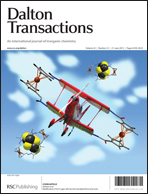Influence of the group 11 metal on the emissive properties of complexes [M{(PR2)2C2B9H10}L]†
Abstract
The metal atoms in group 11 complexes [M{(PR2)2C2B9H10}L] [R = Ph, iPr; L = tertiary phosphane; M = Au, Ag, Cu] play an important role in the emissive properties of these compounds. The influence of the metal follows the order Au ≫ Ag ≥ Cu. The three-coordinated complexes are obtained from the reaction of [AuClL], [Ag(OTf)L], or [Cu(NO3)(PPh3)2] with the closo carborane diphosphane in refluxing
![Graphical abstract: Influence of the group 11 metal on the emissive properties of complexes [M{(PR2)2C2B9H10}L]](/en/Image/Get?imageInfo.ImageType=GA&imageInfo.ImageIdentifier.ManuscriptID=C3DT50434D&imageInfo.ImageIdentifier.Year=2013)

 Please wait while we load your content...
Please wait while we load your content...